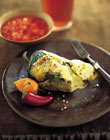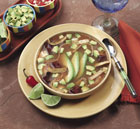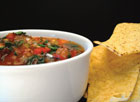
“Mexican ingredients are the cornerstone of the cuisine that has built Chili's very successful menu,” says executive chef Stephen Kalil CRC, CEC, director of Culinary Innovation for Chili's Grill & Bar (Brinker International). “The proliferation of authentic Mexican ingredients has allowed for great innovation in America's restaurants. Look at how fast products like cilantro, chipotle, ancho, masa and poblano have become part of mainstream dining.” Where will this spicy trend lead? First, we should understand why Mexican cuisine took so long to catch on in the States and what factors were instrumental in its becoming popular.

The Hand that Stirs the Pot
One key reason that the foods of our southern neighbor were not well known on American menus was that prior to the late 1980s, most American chefs knew little about real, traditional Mexican cuisine. Few, if any, famous chefs had worked in Mexico. Even fewer had studied there. It would take a series of trends, and a few key trendsetters, to change these attitudes. Perhaps the first great American chef to break this barrier was Rick Bayless, owner of the now famous Frontera Grill in Chicago. Chef Bayless was a visionary. He lived, worked and studied cooking in Mexico at a time most Americans did not think “south of the border” first when choosing either a restaurant or a vacation destination.At that time, Spring Break meant going to Florida. Thousands of college students then flocked to Daytona or Fort Lauderdale as their number-one party spot. Adults dreamed of Hawaii, Paris or Rome. Consumers thought of Mexican food as tacos, burritos and tamales. It was considered inexpensive fast food—tasty and filling, but fattening and unhealthy. Due in part to lack of consumer demand, many authentic, traditional ingredients were simply not available in most U.S. cities. The “Mexican” dishes available here truly were not Mexican cuisine. They were Americanized versions of Mexican street foods. These items were insipid, overly spiced junk foods. Poorly trained American cooks had substituted whatever low-cost ingredient they had at hand, making such foods high in fat and low in quality.
Do you remember Fritos, Tabasco and Cheese Whiz? Separately, all are great products. Together, however, they combine into a nacho nightmare! Even so, many of these American-Mexican dishes appeared on school lunch menus and at church “pot luck” dinners. Then, in the late 1980s and early 1990s, the culinary climate began to change.
In the decade just prior to the recent turn of the century, an entire generation began seeing something new on television. Where their parents had watched family-oriented cartoons, a new generation was watching MTV. Spring Break was now “Live from Cancun!” Hundreds of thousands of young Americans began choosing Mexico as their place to visit. An entire generation began to build a new and more open opinion of all things Mexican.
At the same time, in the famous Commander's Palace Restaurant in New Orleans, chef Paul Prudhome was creating a culinary American revolution. Chef Prudhome used Creole cuisine to teach consumers about “big” flavors. Spicy, intense flavors of Cajun cooking became the rage. Midwesterners in places like Minneapolis, Omaha and Kansas City became accepting of something new and exciting. Restaurants everywhere began putting spice on the menu.
Meanwhile, as teens frolicked in the southern sunshine and Cajun cuisine swept the country, millions of tenacious, hard-working Mexican immigrants arrived in America, hoping for a better life. These new arrivals brought with them their food preferences and culinary skills and put them to good use. Everyone who has worked in a professional cooking capacity understands that the “hand that stirs the pot” does indeed influence the taste of the final product. “Culinary drift” is a term describing the slow but steady movement toward the preferences of the people creating the recipe on a daily basis.
Therefore, the Italian dinner you had last Friday night may well have been cooked by a Mexican chef! Tomorrow's coming culinary trends are being affected by these Mexican restaurant professionals. As informed product developers, we will have to understand and respond to these coming changes.

Authentic Mexican Ingredients
One such informed food product developer is JeanMarie Brownson. Chef Brownson is the director of product innovation with Frontera Foods. Frontera is the retail prepared foods division of Rick Bayless' world famous Frontera Grill Restaurant. For more than a decade, chef Brownson has worked side by side with chef Bayless, creating, developing and manufacturing some of the finest authentic, Mexican prepared food products available today. Frontera products can now be found on upscale supermarket shelves all across America. “Rick truly was the trailblazer,” chef Brownson tells us in a recent interview. “When we started back in '93, it was impossible to get the fresh, high-quality Mexican produce we now use every day. Chef Bayless was the first to partner with local, Midwest farmers and convince them to plant and grow the ingredients we needed. Simple things like fresh ancho or poblano peppers were unknown to Chicago diners. He changed all that. The amazing and delicious menu items he first began serving at Frontera Grill changed America's opinion of Mexican food. I helped Rick work on his first book. The authentic salsas and other products we have developed and now manufacture all derive from those first trend-setting recipes.” Chef Brownson adds, “Today, we see all kinds of high-quality fresh Mexican ingredients in every supermarket. The bestselling books he wrote and the hit television cooking show chef Bayless stars in each week have helped to create a demand for these wonderful, authentic Mexican foods.”The research chefs working at Frontera Foods did help create the current demand for Mexican entrées. Now they are working enthusiastically toward what they believe will be the next trend in Mexican prepared foods. What will that next evolution in American eating be? Chef Brownson is betting it will be a melding of traditional Mexican flavors and good old American favorites. The newest line of truly innovative products being rolled out by Frontera Foods is a line of frozen Mexican pizzas. If anyone can create a great Mexican pizza it will be Rick Bayless. Combining the look and feel of a traditional pizza with the ingredients and flavors of Mexico, these new supermarket items are intended to push the envelope of the Mexican trend.
While every professional chef tips his hat to chef Bayless, not everyone feels that Mexican cuisine is going to become Americanized. “Americans' idea of Mexican foods is in a great time of flux,” states chef Matthew D. Burton CEC, CRC; director of culinary innovation with ConAgra. “People are not afraid of chilies any more. Thanks much in part to chefs like Rick Bayless and Bobby Flay, chilies have been demystified. It amazes me now when I go to the Mexican area of my town and go to the small Mexican grocery stores, I look around and I am no longer the only person in there that speaks English. People are willing to experiment and try items.”
Chef Burton is the key culinary innovator in ConAgra's glorious test kitchens in Omaha. Sharing his recent experiences, chef Burton tells us, “I had the opportunity to join chef Rick Bayless with the CIA on a culinary trip to Mexico a few months ago. The experience was truly eye opening. As a chef, the first thing I had to do was truly forget everything I thought I knew about cooking! The knife cuts, searing of meats, slow simmering, meat butchery; everything was out the window. The true food in Mexico was so much cleaner and less complex than what Americans think of today. There are no giant burritos stuffed with a pound of rice and topped with guacamole and sour cream or smothered tortillas wrapped up and stuffed with tons of cheese. Everything is simple, fresh and clean. It was easy to tell that food really is a central part of the culture, from the street vendors selling atoli in the morning to the little old ladies hand grinding corn to make tortillas so you can eat them immediately; wonderful food was everywhere.”
When asked where he thinks the Mexican trend will lead next, chef Burton says, “The amazing thing is how much healthier real Mexican cuisine is. Tons of fresh vegetables and fruits were everywhere. Much like other ethnic cuisines, meat was very often more of a garnish than the center of the plate. The markets were amazing, stacked floor to ceiling with everything you can imagine. I can still imagine all the wonderful smells and sights for the Mexico City Market--nothing short of culinary heaven! We may see a move toward even more authentic Mexican cuisine. I do not believe it will be much further in the future that you will start seeing tortillas in the bread basket, or the mom whipping up a batch of mole for a Sunday dinner.”
American moms may not be thinking about Sunday dinner mole just now, but the industry's top innovators are saying it may happen soon! The factors that created today's demand for Mexican products continue to gain strength. Understanding those factors and predicting what tomorrow's diners will be ordering, before they order it, is the chef's edge.
Website Resources:
www.PreparedFoods.com -- Type “Mexican food” into LINX search fieldwww.fronterakitchens.com/restaurants -- Information on chef Rick Bayless and his restaurants
www.myhomecooking.net/mexican-food-recipes/mexican-food-recipes.htm -- Several Mexican recipes, with photos of the finished dishes
Sidebar: Mexican Vegetables
•Acitrónes-- Candied prickly pear cactus leaves.•Avocado-- A savory fleshy fruit. Originating in south-central Mexico around 5,000 B.C.
•Chayote-- An edible gourd; once the principal food of the Aztecs and Mayans.
•Huitlacoche-- Mexican corn truffle; a mushroom-like fungus.
•Jicama-- Mexican “potato”; mild-flavored root vegetable.
•Nopales-- Popular Mexican vegetable; leaves of the nopal (prickly pear) cactus.
•Tomatillo-- Small, popular Mexican vegetable, similar in appearance to green tomatoes.
Sidebar: A Glossary of Fresh (Unripened) Mexican Cheeses
•Queso Fresco-- The most popular Mexican-style cheese. Soft and moist with a mild saltiness and slight acidity.•Queso Blanco Fresco-- Also called queso para freir, or cheese for frying. Firm, moist cheese used in cooked dishes.
•Panela-- Mild and moist with a sweet, fresh milk flavor.
•Queso Blanco-- A white, mild, creamy cheese similar to a mild cheddar or jack.
•Oaxaca-- A mild, firm white cheese with a sweet milk flavor and slight saltiness.
•Requesón-- Similar to ricotta; made from whey. Soft, grainy texture and fresh milk taste.
Source: California Dairy Board
A Glossary of Aged Mexican Cheeses
•Asadero-- A mild, firm cheese molded into a log and sold sliced; it is similar to provolone in its slightly tangy taste and firm texture.•Cotija-- Firm, very salty cheese is similar to a dry feta.
•Cotija Añejo-- A mainstay of Mexican cooking. It has a salty flavor and can be grated or crumbled and used like parmesan or dry jack.
•Enchilado-- Dry, crumbly white cheese is similar tocotija añejo, but distinguished by its reddish appearance, the result of a mild red chile or paprika coating.
•Menonita-- A mild, smooth white cheese that originated in the Mennonite community in Chihuahua, Mexico.Menonitais similar in flavor and uses to gouda.
•Manchego-- Derived from the famous cheese of La Mancha, Spain, traditionally made from sheep's milk, the California version is made from part-skim cow's milk.